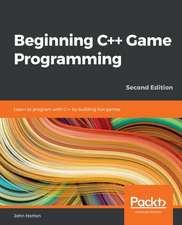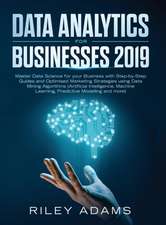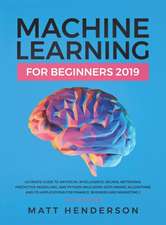Prolog Programming for Artificial Intelligence
Autor Ivan Bratkoen Limba Engleză Paperback – 31 aug 2011
Divided into two parts, the first part of the book introduces the programming language Prolog, while the second part teaches Artificial Intelligence using Prolog as a tool for the implementation of AI techniques. This textbook is meant to teach Prolog as a practical programming tool and so it concentrates on the art of using the basic mechanisms of Prolog to solve interesting problems. The fourth edition has been fully revised and extended to provide an even greater range of applications, making it a self-contained guide to Prolog, AI or AI Programming for students and professional programmers.
Preț: 512.00 lei
Preț vechi: 640.00 lei
-20% Nou
Puncte Express: 768
Preț estimativ în valută:
97.98€ • 101.92$ • 80.89£
97.98€ • 101.92$ • 80.89£
Carte disponibilă
Livrare economică 24 martie-07 aprilie
Livrare express 07-13 martie pentru 47.30 lei
Preluare comenzi: 021 569.72.76
Specificații
ISBN-13: 9780321417466
ISBN-10: 0321417461
Pagini: 696
Ilustrații: Illustrations
Dimensiuni: 171 x 238 x 30 mm
Greutate: 1.01 kg
Ediția:Nouă
Editura: Pearson Education (US)
Locul publicării:Harlow, United Kingdom
ISBN-10: 0321417461
Pagini: 696
Ilustrații: Illustrations
Dimensiuni: 171 x 238 x 30 mm
Greutate: 1.01 kg
Ediția:Nouă
Editura: Pearson Education (US)
Locul publicării:Harlow, United Kingdom
Cuprins
Part i The Prolog Language
1 Introduction to Prolog
2 Syntax and Meaning of Prolog Programs
3 Lists, Operators, Arithmetic
4 Programming Examples
5 Controlling Backtracking
6 Built-in Predicates
7 Constraint Logic Programming
8 Programming Style and Technique
9 Operations on Data Structures
10 Balanced Trees
Part ii Prolog in Artificial Intelligence
11 Problem-Solving as Search
12 Heuristic Search and A* Algorithm
13 Best-First Search: Minimising Time and Space
14 Problem Decomposition and AND/OR Graphs
15 Knowledge Representation and Expert Systems
16 Probabilistic Reasoning with Bayesian Networks
17 Planning
18 Partial order planning and GRAPHPLAN
19 Scheduling, Simulation and Control with CLP
20 Machine Learning
21 Inductive Logic Programming
22 Qualitative Reasoning
23 Language Processing with Grammar Rules
24 Game Playing
25 Meta-Programming
Appendix A: Some Differences Between Prolog Implementations
Appendix B: Some Frequently Used Predicates
Solutions to Selected Exercises
Index
1 Introduction to Prolog
2 Syntax and Meaning of Prolog Programs
3 Lists, Operators, Arithmetic
4 Programming Examples
5 Controlling Backtracking
6 Built-in Predicates
7 Constraint Logic Programming
8 Programming Style and Technique
9 Operations on Data Structures
10 Balanced Trees
Part ii Prolog in Artificial Intelligence
11 Problem-Solving as Search
12 Heuristic Search and A* Algorithm
13 Best-First Search: Minimising Time and Space
14 Problem Decomposition and AND/OR Graphs
15 Knowledge Representation and Expert Systems
16 Probabilistic Reasoning with Bayesian Networks
17 Planning
18 Partial order planning and GRAPHPLAN
19 Scheduling, Simulation and Control with CLP
20 Machine Learning
21 Inductive Logic Programming
22 Qualitative Reasoning
23 Language Processing with Grammar Rules
24 Game Playing
25 Meta-Programming
Appendix A: Some Differences Between Prolog Implementations
Appendix B: Some Frequently Used Predicates
Solutions to Selected Exercises
Index






















